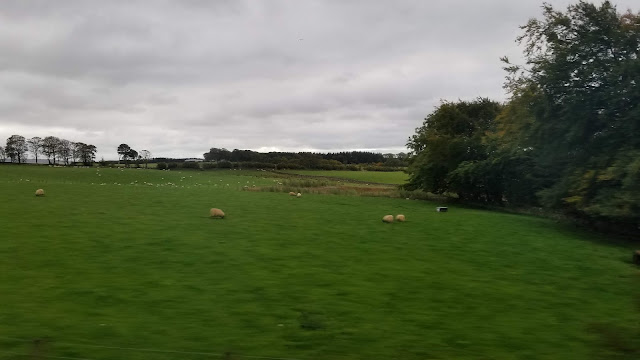We left Edinburgh on a Saturday, headed for Canterbury, England. A fairly easy trip, actually - and normally pretty fast.
Back in the 1960s, it took over 7 hours to get from Edinburgh to London, it's a 400 mile trip, after all. Not too shabby - nearly 60 mph average. That's about what it takes to drive it, today. However, in the 1970s, British Rail developed a 125 mph high speed diesel train and upgraded the track on the route and that shortened the time to about four and a half hours - nearly 90 mph average.
More recently, the entire line has been electrified and Hitachi electric trains have been placed in service, reducing the running time a bit more. This is really decent for lines that were laid down in the middle part of the 19th century. For comparison, Amtrak's Acela only averages 75 mph between New York and Washington.
So, we buy our tickets. A 6:00 trip. Hmmmm. What's up? Turns out they have the high speed, direct, east coast route out of service for a few Saturdays. Our train is going to detour west then south to Carlisle, then back east to Newcastle to the normal east coast route.
We get down to the platform, one of those InterCity 125 trains built in the 1970s greets us. The route from Carlisle to Newcastle isn't electrified, so a diesel powered train-set is needed. It's been nicely modernized on the inside.
Here we go.
 |
| 40+ year old train, back in mainline action! |
 |
| On the way to Carlisle |
 |
| High Speed Train. Low speed sheep. |
 |
| Calling on: Carlisle |
On the way from Carlisle to Newcastle, we crossed the Pennine Mountains on a line that only regularly saw local trains. No 100 mph running there! There were quite a few railfans, out, however. Getting pictures of the HST trains holding down the east coast detour, perhaps?
 |
| Arriving Newcastle |
 |
| Another crown-style steeple |
The railfan mystery cleared itself up in Newcastle. The place was thick with them. As we made our station stop, an unusual train rolled into the station.
 |
| Our train in Newcastle. We changed ends here and headed out the way we came. |
 |
| 40 year old locomotives up to the task? You bet! |
 |
| Rolling through England |
We rolled into Kings Cross on time. No sign of any Hogwarts students heading to 9-3/4.
 |
| Our train-set's power car had a commemorative 50th anniversary plaque honoring the Deltic locomotives |
The trains to Canterbury left every hour. I allowed a 90 minute connection - mostly due to my American mistrust of Amtrak's timekeeping. It wasn't wasted time. We got a snack, scouted out our train's platform and ATM'd some pounds.
 |
| Hitachi 140 mph electric trains. Javelins (not the AMC type) |
At Ashford, the our Javelin exited the old, 60 mph line up to Margate on the coast. Canterbury is about half way up that line. The train used old-fashioned 750 VDC propulsion on that line.
 |
| Departing Canterbury West Station. The new, high speed train and the ancient signal tower make for an unusual, very British scene. |
Not a bad way to spend a day!








Great pictures and a great report. It strikes me that there are a lot of good lessons here for improving America's passenger rail network. Focus on relatively short, high density corridors. Step up frequencies and speed in increments instead of going all out to duplicate the Chinese, Japanese, and French versions of high speed rail.
ReplyDeleteSome of the folks in Dallas and Houston are salivating over the proposed Texas Central Railway, which will run from Big D to Houston. But the most congested corridor in Texas is between DFW and San Antonio. This is were a real alternative to driving is needed. A realistic upgrading of the route along the lines of the British model could be a great step in the right direction.
Thanks, Don.
ReplyDelete